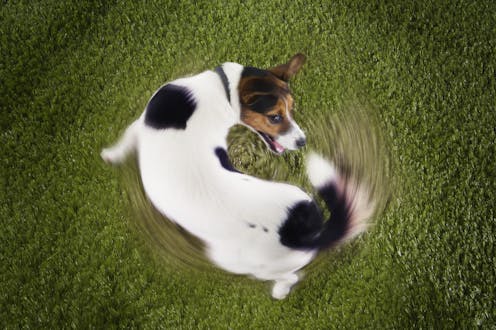Why do cats and dogs get the zoomies?
- Written by Susan Hazel, Associate Professor, School of Animal and Veterinary Science, University of Adelaide

Does your cat or dog suddenly get a burst of energy and perform athletic feats around the house that would make even a gold medallist jealous? Welcome to the world of zoomies.
Zoomies involve intense periods of high-energy activity including running, spinning, jumping and rolling. All at top speed.
A proposed scientific name is frenetic random activity periods (FRAPs). In rabbits these high activity periods are called “binkies”. But many cat and dog owners simply call them “zoomies”.
So why do our animals experience the zoomies? And is it something we should be worried about?
Read more: Why do cats knead?
Why do animals get the zoomies?
Think about when your cat or dog gets the zoomies.
You might see post-bath zoomies, dog park-zoomies, midnight-zoomies and good ol’ out-of-nowhere zoomies.
The trigger may be excitement or a sudden increase in stimulation.
In cats, a commonly reported trigger is using the litter tray. This may be explained by “poo-phoria”, a feeling of euphoria following defecation. This is possibly caused by large bowel movements stimulating the vagus nerve, resulting in positive feelings and a drop in heart rate and blood pressure.
Zoomies can be characterised as play as the two behaviours share many of the same characteristics. This would make zoomies intrinsically pleasurable – in other words, a whole load of fun.
If the zoomies are occurring as part of your animal’s regular play routine, this indicates your animal is happy and enjoying themselves.
While we don’t yet know if zoomies are more likely to occur at certain times of the day, or more in some breeds compared with others, we do consider them a general indication of a high level of excitement – and likely a pretty good mood.
Humans are animals too and some people also experience what could be similar to the “zoomies”.
Ever get a sudden feeling of intense excitement and spare energy? Maybe you’ve felt the need to jump, shake or dance, before it wears off and you’re back to your regular settings.
This can be caused by a multitude of things – an exciting or novel situation, a spike in energy after a extended period of resting or perhaps a change in your inner chemistry. Perhaps you got a rush of adrenaline caused by excitement, over-stimulation or stress.
Are zoomies always a sign your cat or dog is happy?
It’s important to remember animals are individuals and, just like us, why they behave the way they do is complex and multifaceted.
When assessing your animal’s behaviour, it’s essential to also assess the context.
Zoomies are mentioned a lot online, but there is a real lack of scientific research on what causes them, how often they occur, or even an official definition of what they are.
Ask yourself: am I invited to the zoomie?
In dogs and cats, zoomies can include an invitation for others to join – in dogs this is most commonly a play bow, where the dog appears to “bow” to another in an effort to signal it is keen to play – followed by a pause commonly seen in dyadic play (play between two or more individuals).
In cats, an invitation may include physically interacting with you or repeatedly rolling over. If this is the case, your animal is likely experiencing excitement and a desire to interact with you.
What do I do during a zoomie outbreak?
Unless there’s an element of immediate danger (such as zoomies on or near a road) there is no reason to stop your cat or dog from enjoying their burst of fun.
Cats and dogs are often superstars at avoiding obstacles even at high speed. If you’re lucky enough to receive invitations to partake in the chaos, feel free to join in the play.
Enjoying shared activities such as play with your dog or cat can have many benefits for the human-animal relationship. It’s also a lot of fun for you!
When should I be worried?
Zoomies are usually a completely normal (and fun) part of being a dog or cat.
Sometimes, however, it may be a symptom of either stress or an underlying medical condition.
As always, context is key. You should consult with your veterinarian if your dog or cat is displaying the behaviour for extended periods of time (in particular, spinning, or behaviours occurring during times of confinement). These might be signs of a repetitive behaviour disorder.
If you struggle to distract or stop the behaviour, or if it is resulting in injuries, seek veterinary assistance.
Even if you don’t get the call of the zoomies yourself, take a moment to stop and enjoy your dog or cat having fun.
Sometimes we all need to run wild.
Read more: Dogs can get dementia – but lots of walks may lower the risk
Authors: Susan Hazel, Associate Professor, School of Animal and Veterinary Science, University of Adelaide
Read more https://theconversation.com/why-do-cats-and-dogs-get-the-zoomies-197790





